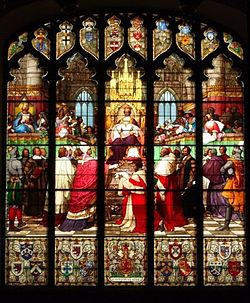Portal:Scotland/Selected articles/86

The Kingdom of Scotland (Scottish Gaelic: Rìoghachd na h-Alba; Scots: Kinrick o Scotland, Norn: Kongungdum Skotland) was a sovereign state in northwest Europe, traditionally said to have been founded in 843. Its territories expanded and shrank, but it came to occupy the northern third of the island of Great Britain, sharing a land border to the south with the Kingdom of England. During the Middle Ages, Scotland engaged in intermittent conflict with England, most prominently the Wars of Scottish Independence, which saw the Scots assert their independence from the English. Following the annexation of the Hebrides and the Northern Isles from Norway in 1266 and 1472 respectively, and the capture of Berwick by England in 1482, the territory of the Kingdom of Scotland corresponded to that of modern-day Scotland, bounded by the North Sea to the east, the Atlantic Ocean to the north and west, and the North Channel and Irish Sea to the southwest.
In 1603, James VI of Scotland became King of England, joining Scotland with England in a personal union. In 1707, during the reign of Queen Anne, the two kingdoms were united to form the Kingdom of Great Britain under the terms of the Acts of Union. The Crown was the most important element of Scotland's government. The Scottish monarchy in the Middle Ages was a largely itinerant institution, before Edinburgh developed as a capital city in the second half of the 15th century. The Crown remained at the centre of political life and in the 16th century emerged as a major centre of display and artistic patronage, until it was effectively dissolved with the 1603 Union of Crowns. The Scottish Crown adopted the conventional offices of western European monarchical states of the time and developed a Privy Council and great offices of state. Parliament also emerged as a major legal institution, gaining an oversight of taxation and policy, but was never as central to the national life. In the early period, the kings of the Scots depended on the great lords—the mormaers and toísechs—but from the reign of David I, sheriffdoms were introduced, which allowed more direct control and gradually limited the power of the major lordships. (Full article...) Read more...
